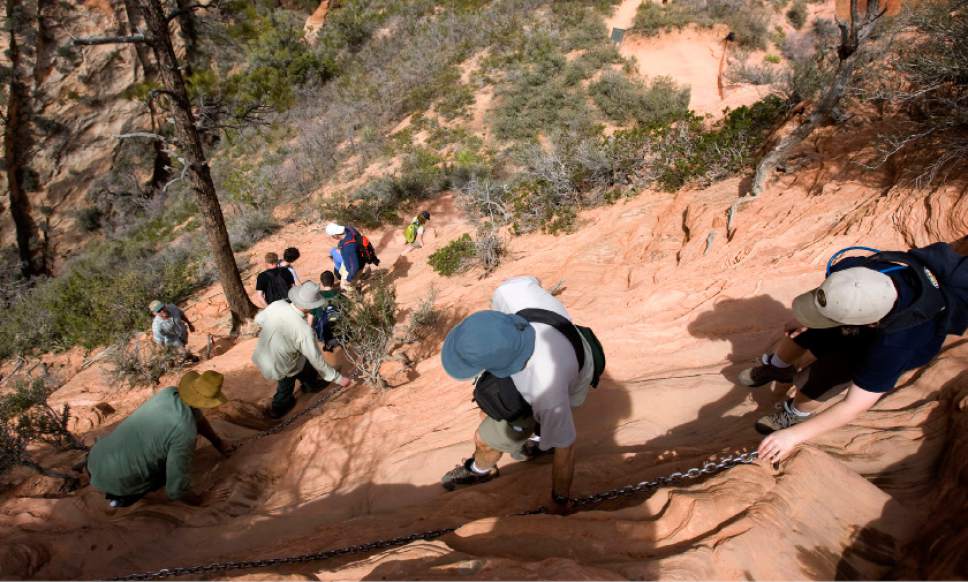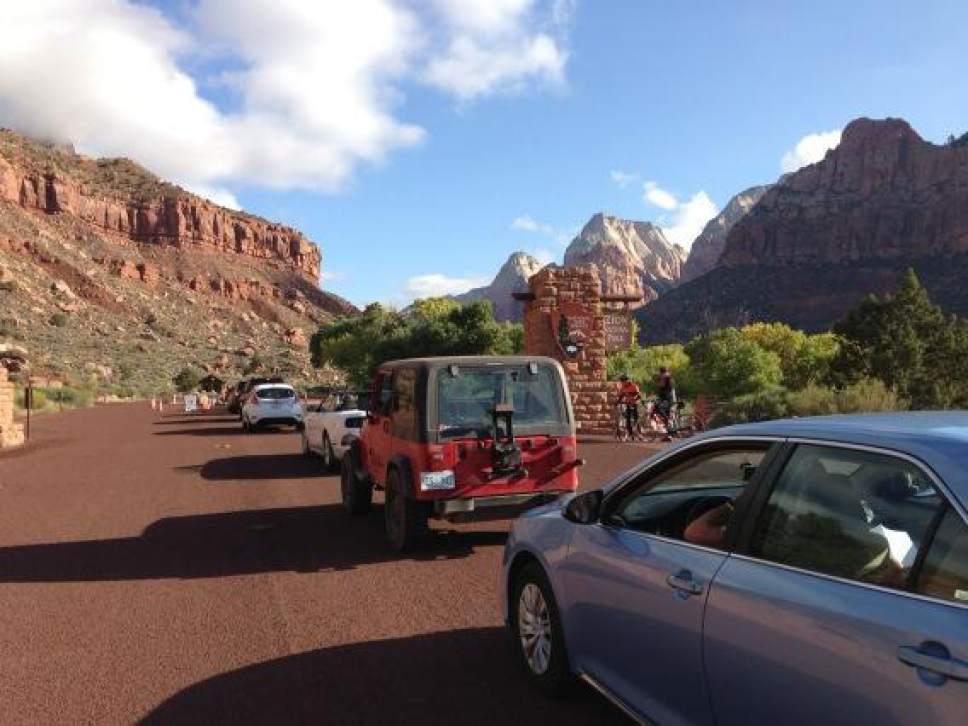This is an archived article that was published on sltrib.com in 2016, and information in the article may be outdated. It is provided only for personal research purposes and may not be reprinted.
Even by Utah standards, few things are as beautiful as snow on redrock, especially in Zion Canyon where visitors can take in this lovely sight this week in the stillness of winter — if they can get there.
It may be the middle of the "offseason," but the canyon, the centerpiece of Zion National Park, has been so packed since Christmas that park officials have had to exclude tour buses and oversize vehicles and close the canyon road because no more vehicles can fit in the parking areas. Traffic has periodically backed so far into Springdale from the south entrance that officials had to "flush" the vehicles through the toll gate, foregoing the revenue that comes with the $30-per-vehicle charge.
And that was even before the long New Year's weekend had quite arrived.
Visitation is expected to exceed a record 4 million visits in 2016, up from 2.7 million six years ago, prompting officials to initiate a process to craft a "visitor use management plan." December and January are typically the least busy time for the park, with monthly visitation below 100,000. But the winter months have seen the greatest percentage increases in recent years, growing by nearly 70 percent since 2010.
Utah's busiest park has become a year-round destination, and overcrowding is no longer limited to the high season of spring, summer and fall — the park's shoulder-season window is closing.
"It used to be a time to breathe, regroup and rehire," said park ranger John Marciano on Friday in a brief phone interview as he was rushing off to the visitor's center to relieve overworked staff. "Many of the park rangers have different positions. We are stretched so thin we have to rotate positions."
Some Springdale residents have begun imploring the state to tone down the "Mighty Five" advertising campaign that leverages the national parks to draw tourists.
"We are ruining our park with too many people. It has not been fun. Those park employees, you have to feel for them. They are feeling the brunt of it," said Lisa Zumpft, a Springdale councilwoman and a park volunteer. "I want to protect the park first so we don't destroy it. I would like to see our town protected because it is losing its character."
An indication of that changing character was the recent demolition of the Canyon Ranch, a small historic enclave of cabins along the main drag that is to be replaced by a large Best Western hotel.
This week's hordes were a sign of the times. Lines of cars arrived at the park entrance every day, backing traffic nearly three-quarters of mile into town, creating shortages of places to park. Even ice-covered trails were packed with hikers seeking to enjoy the Riverside Walk, Weeping Rock Emerald Pools and other destinations where the Virgin River has sliced a 1,000-foot deep gorge through ancient sandstone.
The park closed access to some of these destinations Monday because of falling ice. Officials urge visitors who wish to hike to wear traction devices on their shoes.
Zion's mandatory shuttle system stopped daily service at the end of October, and continued operating weekends only through November. With no shuttles operating till March, winter visitors are essentially forced to drive into the narrow canyon.
Gallery owner Tina Fairlamb would like to see shuttle service offered on weekends through winter, but has no idea how the park would find the money.
"The time between Christmas and New Year's has been picking up in the last few years," said Fairlamb. "I can't say crowds in the park have translated into crowds for the businesses. Maybe for the restaurant and the hotels. On Wednesday, we had 10 people. On Thursday we had 43. There's no rhyme or reason. This week, I see a lot of cars coming and going, but I don't see a lot stopping."
The National Park Service is scrambling to balance the heavy visitation with protecting the park's resources and visitor experience.
"With increasingly concentrated use and overwhelmed facilities, we are concerned with health and safety issues; diminishing quality of visitor experiences; and associated impacts to soils, vegetation, water, wildlife habitat, soundscapes, and cultural resources," said park superintendent Jeff Bradybaugh back in October when he solicited public input on the planning process.
The park service will release the plan's preliminary alternatives this spring, followed by a draft environmental assessment next fall. A final decision is expected by fall 2018.
"We are supportive of them actively managing visitors. That is going to require some limited numbers. The plan is trying to identify what [the park's] carrying capacity is. They feel they are beyond that," said Cory MacNulty of the National Parks Conservation Association. "They are at their capacity financially. It is so expensive to run the shuttle. They don't have the staffing this time of year. They don't have the resources to do two rounds of seasonal employees."
While many visitors may chafe at officials managing their experience of the park, something must be done to spread visitors around so they are not on top of each other, officials say.
Traffic is often gridlocked in Springdale, waits to board the shuttle bus can stretch to two hours, and popular trails are so crowded that walkers have to turn sideways to pass others. This increases the danger of falls where trails are cut near a precipice such as those ascending Angels Landing and Observation Point. More visitors are getting into trouble. According to park officials, emergency calls increased from 389 in 2011 to 686 in 2015.
Some of the options under consideration include a timed-entry system and a reservation system to ensure capacity levels are not exceeded at certain destinations. The park is looking at developing "multimodal trail" through the canyon that would encourage non-motorized travel and better integrate with the shuttle stops and points of interest. The first-come, first-served system at South Campground could be replaced with reservation-only camping and automated gates could be used to allow those who prepay to drive into the park without stopping.
Brian Maffly covers public lands for The Salt Lake Tribune. Brian Maffly can be reached at bmaffly@sltrib.com or 801-257-8713. Twitter: @brianmaffly







